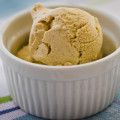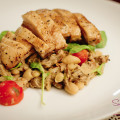 Blood orange + olive oil? Is this one of those zany food combos that tastes amazing?” asked one of my friends when I posted this photo. Yes, indeedy, it is.
Blood orange + olive oil? Is this one of those zany food combos that tastes amazing?” asked one of my friends when I posted this photo. Yes, indeedy, it is.
Ever since discovering it at a shop in Santa Fe, New Mexico, Shake and I have been head over heels in love with blood orange olive oil. It’s my go-to salad dressing: a drizzle of blood orange olive oil and a drizzle of vanilla balsamic vinegar. Simple and delicious. When the bottle we bought on our trip ran out, Shake found a BIG bottle of a different brand at Williams-Sonoma. We were pretty stoked until we realized that it wasn’t as good. (Not bad, just not as good.)
 That’s a bottle of the good stuff on the right, from Oleaceae, and the “eh, it’s OK…” stuff on the left.
That’s a bottle of the good stuff on the right, from Oleaceae, and the “eh, it’s OK…” stuff on the left.
I ended up buying a new bottle of the prized Oleaceae blood orange olive oil recently, which meant that the other big bottle of not-quite-as-good stuff needed a purpose. I can’t just throw something like that away. But what on earth do you do with something with that unique a flavor profile when you have so much of it?
I started thinking of all the odd things that I’d heard of being made with olive oil. Cookies. Those were pretty good. But I’ve been short on time, and baking seemed just too…involved. Maybe I could confit something in it? Meh…again, too time consuming. And what if it came out horribly? All weird and fruity in a way it shouldn’t be?
I’d once heard of olive oil ice cream. The bright orange taste of the oil seemed like it would make this odd dessert item taste much better. (I’m a fan of fruity olive oils, but even I’m not sure if I’d want regular olive oil ice cream.) And I could just dump the ice cream base in and let it go to town in the machine while I wandered away to do other things.
“I smell fruit,” proclaimed Shake, wandering into the kitchen. “You’re making what?” [Imagine skeptical face here.] “Okay…”
The next day (I had to chill the base), “Here, eat this,” I said, waving a spatula around under his nose. “Hurry up before it melts!”
“Mmmm, what’s that smell?”
“I told you, blood orange olive oil.”
“All that orangey smell is just from the oil? The junky one?”
“Shocking, right?”
Turned out, the meh oil was pretty good in ice cream! Without anything else to compete with, it had enough citrus oomph to smell up the kitchen. It added a distinctive, floral orange taste to the ice cream. If you weren’t told there was olive oil, you’d never guess it. The one drawback is that because of the oil, you really have to scrub the dishes. Everything the ice cream touches gets greasy. I’ll definitely be making this again. I’m not sure if I’ll use my precious Oleaceae oil to do it, but I still have quite a bit of the other brand left.
You may notice that there are some oranges in these photos, and a little dusting of orange zest atop the ice cream. So, here’s the story behind that: I wanted to add a little blood orange zest to the ice cream base before mixing it.
I couldn’t find any blood oranges. (I checked two markets; frustratingly, one had a price sign for them, but no oranges. Grr.) I did find some lovely looking Satsuma tangerines at Whole Foods, though. Oh, well, these will do, I thought.
No, no they will not. Here’s something to file away in your mental notes: tangerines have MUCH thinner skin than oranges. You probably know that. Intellectually, I know that. It never occurred to me that thick skin is what produces a nice zest. I zested, being careful not to smoosh my tangerines, and — I thought — avoiding grating through the skin entirely. No luck. I didn’t get much zest, what I got was really wet, not crumbly, and when I tasted it, it was super bitter. So it turned out to be a good thing that I completely spaced out and forgot to try to zest the tangerines before making the base! I made my no-zest discovery a few days later when I did this photo shoot, and sprinkled the paltry zest bits I could muster up just for the sake of color.
See, sometimes screwing up in the kitchen ends up being a very good thing.
The recipe I used was posted by a blogger, from Dorie Greenspan’s Around My French Table. I’m not sure if the blogger miscopied it, or if the original really does forget to tell you when to add vanilla extract (not that you’d need to be a rocket scientist to figure it out), but I ultimately decided to forego the extract, for fear that it would color my ice cream. I’m thinking of tinkering with this recipe further to add honey. I’ll let you know how that goes.
At any rate, I’m reposting the recipe here with a few edits to help you if you, as I do, live in a ridiculously hot house.
Blood Orange Olive Oil Ice Cream
Adapted from Dorie Greenspan’s Around My French Table
Our favorite blood orange olive oil is from Oleaceae, but the Stonehouse brand we found, although not as good on salads, worked very nicely here.
When working in a home as hot as ours gets, it’s helpful to chill all your bowls. I place two metal mixing bowls, nested in each other, in the fridge a couple hours in advance. The smaller of the two should be able to hold at least 5 cups of liquid.
- 5 large egg yolks
- ½ cup sugar
- ⅛ teaspoon of salt
- 2 cups whole milk
- 1 cup heavy cream
- ½ cup blood orange olive oil
Whisk egg yolks thoroughly in a large bowl (this one doesn’t need to be chilled). Set aside.
Whisk together sugar and salt in a medium saucepan. Turn heat to medium and add milk and cream. Stir until dissolved together and slightly warm. Transfer to a 4-cup measuring cup with spout, to make it easier to pour. (If not all the liquid will fit in the cup, it’s OK; just leave it in the pan.)
Set up an ice bath, using the two pre-chilled bowls. (Add ice to the bottom of the larger bowl and set the smaller on top. Add cold water to the larger bowl until it reaches half way.) Set a mesh strainer over the smaller bowl.
Slowly pour the warmed mixture into the egg yolks, whisking without stopping, until smooth. Return to the saucepan and cook over medium heat, stirring and scraping the bottom and sides of the pan constantly, until the custard thickens. When it coats a spatula or back of a spoon without running, it’s ready.
Pour the custard through the strainer, discarding the solids left behind. Add the olive oil, and whisk well until the oil is completely blended in. You shouldn’t see any blobby puddles of oil. Cover the mixture and refrigerate 2 hours or overnight. If your place is hot, chill it overnight if at all possible. Churn according to your ice cream maker’s instructions.









Leave a Comment